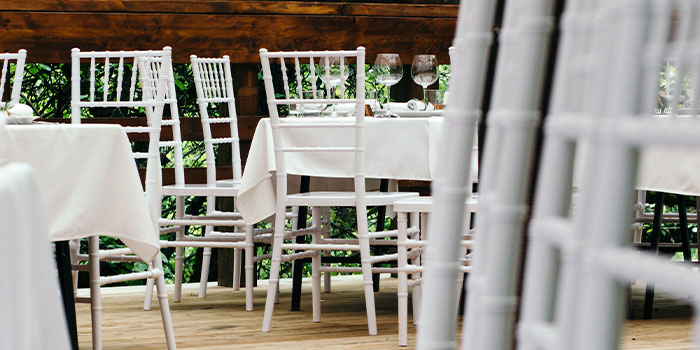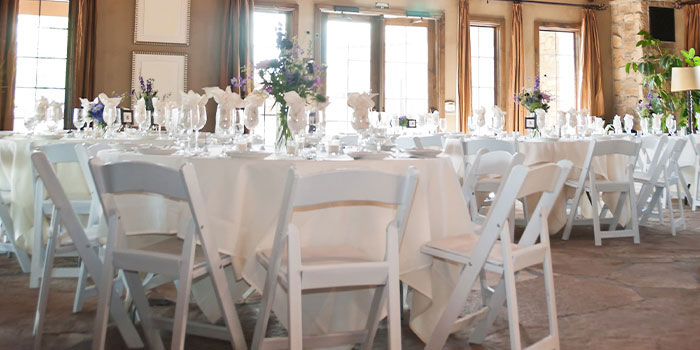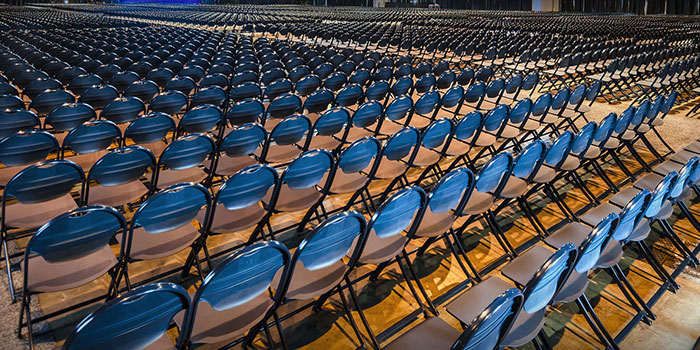
Just like the clothing you wear, chair upholstery needs to be washed. Doing some regular, light cleaning is the best way to keep your chairs looking nice.
Here you will find detailed instructions for how to clean upholstery fabric types used on MityLite chairs.
Disinfect Chair Upholstery to Prevent the Spread of Germs
Are you worried about minimizing the spread of bacteria and viruses at your events? EPA-registered disinfectants that meet the criteria for use against SARS can also be used to sanitize fabric and prevent the spread of the coronavirus and other contagious illnesses.
The Centers for Disease Control recommends using the following products to sanitize chairs and tables in public areas.
- Asepticare™
- Bleach 1:10 (10% bleach)
- Bleach-Rite® Disinfecting Spray
- CaviCide™
- CaviCide1™
- Clorox® Healthcare Bleach Germicidal Cleaner
- Clorox® Hydrogen Peroxide Cleaner Disinfectant Spray
- Diversey™ Avert® Sporicidal Disinfectant Cleaner
- Lysol’s Clean & Fresh Multi-Surface Cleaner
- Oxivir® 1 RTU
- Oxivir® TB
- OxyCide™ Daily Disinfectant Cleaner
- Virex II 256
How to Clean Olefin Fabric (including Sherpa & Shire Fabrics)

For Sherpa and Shire upholstery (and other 100% olefin fabrics), the following disinfecting treatment is recommended to disinfect against germs and viruses, even against the coronavirus (COVID-19).
Use a household bleach (that includes 5.25% or 6.00%–6.15% sodium hypochlorite depending on the manufacturer label) diluted in water at a 1:10 dilution ratio, which is 1.5 cups of bleach in 1 gallon of water. The use of bleach on Sherpa and Shire olefin fabric will not have a harmful effect and the recommended treatments will not void the warranty. However, it is still recommended to test the cleaning solution in an inconspicuous area first before using it throughout.
Prepare the solution fresh before each use, as bleach is sensitive to light. Also, note that bleach expires one year after production, and it can lose efficacy if not stored properly.
Remove organic soil and bulk spill matter prior to disinfecting. Disinfection requires a recommended wet contact time of 10 minutes to be effective. Remember that chlorine solutions are corrosive and can pit metal and damage skin.
Never mix bleach with any product containing ammonia or acids.
How to Clean 100% Polyester Upholstery & Polyester Blends
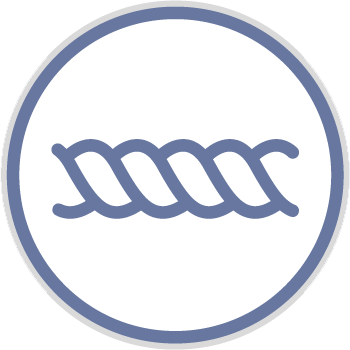
When cleaning upholstery that is manufactured with 100% polyester or polyester blends, it’s best to use hydrogen peroxide products.
We recommend using something like Clorox® Hydrogen Peroxide Cleaner & Disinfectant. This product, which is available as both a spray (for fabrics) and a wipe (for hard surfaces), will kill pathogens on both hard and soft surfaces and can eliminate bacteria and viruses in 30 seconds. This industrial-grade cleaner can be applied to a variety of fabrics, including those that are 100% polyester. This cleaner has no volatile organic compounds (VOCs), harsh fumes, bleach, or added fragrance, and the active ingredient, hydrogen peroxide, breaks down into water and oxygen upon use. However, it’s still recommended to test the cleaning solution first on a small, inconspicuous area.
Be aware that polyester and polyester blend fabrics are sensitive to the effects of bleach. A 3% bleach solution (1/3 cup bleach to 1 gallon of water) is the highest concentration that can be used, but it cannot be guaranteed that long-term use of a bleach solution will not pose a problem.
Another recommended product for cleaning upholstery is Lysol® Clean & Fresh Multi-Surface Cleaner, which is also EPA-registered for its virus-fighting abilities and kills 99.9% of viruses and bacteria. However, the active ingredient, alkyl dimethyl benzyl ammonium chloride, has been implicated in various adverse health effects, so you’ll want to avoid skin contact, inhalation, or accidental ingestion.
As with all potent cleaners, keep away from kids, apply only in well-ventilated areas, and wash surfaces with clean water after use.
How to Clean Crypton & Nanotex Fabric
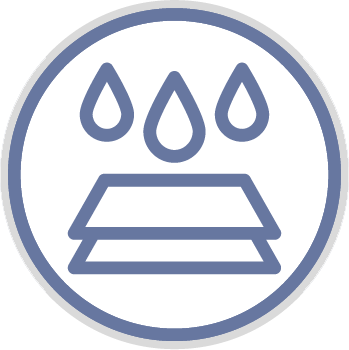
Nanotex and Crypton fabrics are multi-tiered materials with antimicrobial and stain-resistant technology and an integrated, permanent liquid barrier. Crypton’s patented moisture barrier is proven to prevent solids and liquids from permeating to the cushion below. This makes Crypton fabric one of the easiest upholstery fabrics to clean.
However, it is possible for a surface to appear clean but not be disinfected. Crypton recommends using their EPA-approved Disinfectant & Deodorizer on Crypton Barrier Fabrics. This formula is engineered for high-use, high-abuse settings. This is a one-step disinfectant cleaner that is effective against a broad spectrum of bacteria, viruses, mold, mildew, and fungus.
Best of all, this disinfectant is effective in preventing the spread of bacteria and viruses.
To thoroughly disinfect and clean the fabric, use the following steps:
- Remove spills with an absorbent cloth or paper towel. If necessary, clean heavily soiled areas with soap and water.
- Remove excess moisture and soap via vacuum or by wiping with a clean, dry cloth. Remove all soap so that it does not attract soil.
- Test the Crypton Disinfectant & Deodorizer in a small, inconspicuous area.
- Apply Crypton’s Disinfectant & Deodorizer by holding it 6-8 inches from surface. Do not inhale fumes from the spray.
- Rinse the fabric with water after application.
- Allow the surface to remain wet for 10 minutes.
- After 10 minutes, wipe dry or allow to air dry.
How to Clean Woven & Coated Polyester Fabrics
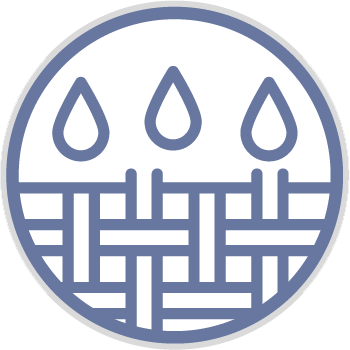
For general maintenance of woven and coated polyester fabrics, regularly vacuum surfaces to remove all dust and loose particles, clean any soil or stain areas, and regularly disinfect.
To disinfect, first confirm that it is safe to use bleach on your product by testing a small area in an inconspicuous spot. Mix a solution of bleach and clean water with a ratio of 1:10. Protect and cover the furniture framework along with surrounding areas, and work in a well-ventilated area with gloves and eye protection.
After disinfecting the upholstery, rinse it well multiple times with clean water. Any bleach left on the fabric may degrade or shorten the lifespan of the fabric.
How to Clean Woven & Knit Fabrics

The following list of suggested cleaners can be used to disinfect woven and knit fabrics and prevent the spread of viruses, bacteria, and other contagious illnesses. Note that these cleaning products have not been rigorously tested against all fabric types and styles, so the information that follows should be regarded as general suggestions rather than recommendations. Always test the cleaning solution first on a small, inconspicuous area.
- Lysol Disinfectant Spray
- Peroxide-based wipes (various brands)
- Alcohol wipes with or without quaternary disinfectant (various brands)
Disinfecting instructions:
Lightly wet the fabric and allow it to air-dry. Note that when using wipes, if color is transferred onto the wipe, the fabric is not colorfast to that product, and these wipes should not be used. Avoid the use of bleach-based wipes unless the fabric is known to be colorfast to bleach. If unknown, assume the fabric is not bleach-safe.
Disinfecting in healthcare environments:
Most hospital disinfectants are intended for use on hard surfaces and are generally not appropriate for woven or knit fabric. However, limited testing has been done with the following cleaning products, and they do not appear to affect the color or integrity of the fabric. Carefully follow label instructions, especially regarding dilution of the disinfectant.
- Virex II 256
- Oxivir TB
- Super Sani Cloth Germicidal Wipes
- Cavicide and Cavicide Wipes
Instructions for disinfecting in healthcare environments:
Lightly wet the fabric surface and allow it to dry—do not saturate the fabric. If repeated applications are anticipated, rinse with clear water to prevent the buildup of chemical residue on the fabric.
How to Clean Polyurethane Upholstery

For general maintenance of polyurethane fabrics, regularly vacuum surfaces to remove all dust and loose particles, clean any soil or stain areas, and disinfect.
Treat stains as quickly as possible. It will become increasingly difficult to remove a stain the longer it’s allowed to set. Remove solid or semi-solid substances by using a flat object. Remove as much of the stain as possible and then vacuum thoroughly using the proper attachments before cleaning with an agent.
Pre-test any cleaning method or disinfecting agent in a small, hidden, inconspicuous area to ensure it won’t damage the fabric. We recommend using several less concentrated applications of cleaning solutions rather than one concentrated application because that will be less likely to damage the fabric. You should also protect and cover the furniture framework along with surrounding areas, and work in a well-ventilated area with gloves and eye protection.
Avoid allowing cleaning fluids to penetrate the surface of the fabric. Remove fluids immediately by blotting with a clean, colorfast, absorbent cloth.
Remove stains by using a soft brush or sponge and then apply warm, soapy water to the stain. Do not over-wet as this may leave a ring and soak up any remaining cleaning solution. Use light, quick strokes, and start from the outside of the stain and work towards the center. Avoid rubbing or scrubbing the area as this may damage the fabric. Use a clean cloth and cool water to remove any residue.
Allow fabric to dry thoroughly and do not use heat, as that will set the stain into the fabric. As with woven and knit fabrics, rinse well after applying bleach to avoid degrading the fabric.
How to Clean Vinyl (PVC) Upholstery

To disinfect PVC (polyvinyl chloride) vinyl upholstery, we recommend using these EPA-approved solutions which have been shown to sanitize against COVID-19 and other strains of the coronavirus.
- A solution of 10% bleach mixed with 90% clean water
- Super Sani-cloths
- Virex™ II, 256
Always, pre-test any cleaning method or agent in a small, hidden, inconspicuous area to ensure it won’t damage the fabric.
Note that cleaners and disinfectants should be used in recommended dilutions and never in a concentrated form. Make sure to wipe off disinfectants with clean water and then dry the vinyl with a clean towel to remove any chemical residue that could discolor or degrade the material’s surface.
When Upholstery Cleaning Isn’t Enough
If your event chairs have started to show their age and cleaning and disinfecting aren’t doing the trick anymore, perhaps it’s time to upgrade or replace them. Browse MityLite’s catalog of durable upholstered banquet chairs.

Upgrade your space with new furniture. Contact a sales rep today!
